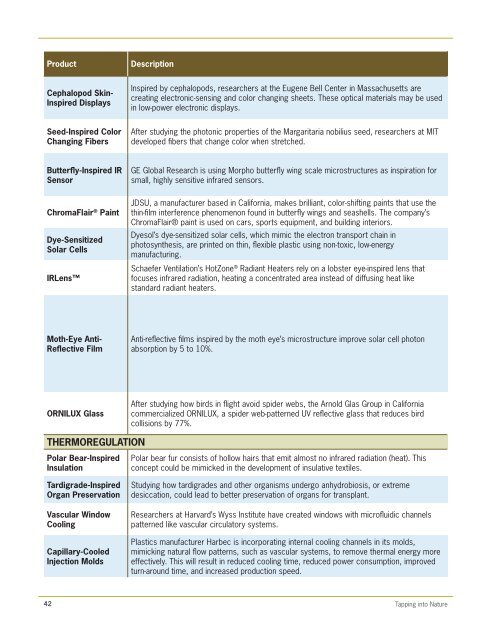Tapping-into-Nature-2015p
Tapping-into-Nature-2015p
Tapping-into-Nature-2015p
Create successful ePaper yourself
Turn your PDF publications into a flip-book with our unique Google optimized e-Paper software.
ProductDescriptionCephalopod Skin-Inspired DisplaysInspired by cephalopods, researchers at the Eugene Bell Center in Massachusetts arecreating electronic-sensing and color changing sheets. These optical materials may be usedin low-power electronic displays.Seed-Inspired ColorChanging FibersAfter studying the photonic properties of the Margaritaria nobilius seed, researchers at MITdeveloped fibers that change color when stretched.Butterfly-Inspired IRSensorChromaFlair ® PaintDye-SensitizedSolar CellsIRLensGE Global Research is using Morpho butterfly wing scale microstructures as inspiration forsmall, highly sensitive infrared sensors.JDSU, a manufacturer based in California, makes brilliant, color-shifting paints that use thethin-film interference phenomenon found in butterfly wings and seashells. The company’sChromaFlair® paint is used on cars, sports equipment, and building interiors.Dyesol’s dye-sensitized solar cells, which mimic the electron transport chain inphotosynthesis, are printed on thin, flexible plastic using non-toxic, low-energymanufacturing.Schaefer Ventilation’s HotZone ® Radiant Heaters rely on a lobster eye-inspired lens thatfocuses infrared radiation, heating a concentrated area instead of diffusing heat likestandard radiant heaters.Moth-Eye Anti-Reflective FilmAnti-reflective films inspired by the moth eye’s microstructure improve solar cell photonabsorption by 5 to 10%.ORNILUX GlassAfter studying how birds in flight avoid spider webs, the Arnold Glas Group in Californiacommercialized ORNILUX, a spider web-patterned UV reflective glass that reduces birdcollisions by 77%.THERMOREGULATIONPolar Bear-InspiredInsulationTardigrade-InspiredOrgan PreservationVascular WindowCoolingCapillary-CooledInjection MoldsPolar bear fur consists of hollow hairs that emit almost no infrared radiation (heat). Thisconcept could be mimicked in the development of insulative textiles.Studying how tardigrades and other organisms undergo anhydrobiosis, or extremedesiccation, could lead to better preservation of organs for transplant.Researchers at Harvard’s Wyss Institute have created windows with microfluidic channelspatterned like vascular circulatory systems.Plastics manufacturer Harbec is incorporating internal cooling channels in its molds,mimicking natural flow patterns, such as vascular systems, to remove thermal energy moreeffectively. This will result in reduced cooling time, reduced power consumption, improvedturn-around time, and increased production speed.42<strong>Tapping</strong> <strong>into</strong> <strong>Nature</strong>


